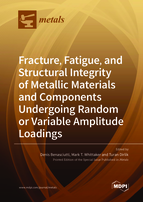Fracture, Fatigue, and Structural Integrity of Metallic Materials and Components Undergoing Random or Variable Amplitude Loadings
A special issue of Metals (ISSN 2075-4701). This special issue belongs to the section "Metal Failure Analysis".
Deadline for manuscript submissions: closed (28 February 2022) | Viewed by 31682
Special Issue Editors
Interests: structural integrity assessment; vibration fatigue; multiaxial fatigue; metal plasticity; finite element analysis
Special Issues, Collections and Topics in MDPI journals
Interests: fatigue; creep; thermo-mechanical fatigue (TMF); superalloys; lifing; nickel alloys; titanium alloys
Special Issues, Collections and Topics in MDPI journals
Special Issue Information
Dear Colleagues,
In casting a glance at engineering and industrial fields, it is often discovered that a large part of metallic components and structures are subjected, in service, to random or variable amplitude loadings. The examples are many: vehicles subjected to loadings and vibrations caused by road irregularity and engine, structures exposed to wind, off-shore platforms undergoing wave-loadings, and so on.
Just like constant amplitude loadings, random and variable amplitude loadings can make fatigue cracks initiate and propagate, even up to catastrophic failures. Engineers faced with the problem of estimating the structural integrity and the fatigue strength of metallic structures, or their propensity to fracture, usually make use of theoretical or experimental approaches, or both. Counting methods (e.g., rainflow) provide information on the fatigue cycles in the load, whereas damage accumulation laws (as the celebrated Palmgren–Miner linear rule) establish how to sum up the damage of each counted cycle. In structural integrity, this is named as the “time-domain” approach. Over recent years, the “frequency-domain” approach has also received increasing and widespread use, especially with random loadings; this approach estimates fatigue life based on load statistical properties represented, in frequency-domain, by a power spectral density. Neither of the previous approaches, however, can do without the support of experimental laboratory testing, which provides a means to collect material strength data under specific loading conditions or to verify preliminary estimations.
The purpose of this Special Issue is to collect articles aimed at providing an up-to-date overview of several topics in the field of fracture, fatigue strength, and the structural integrity of metallic components subjected to random or variable amplitude loadings. Researchers are encouraged to submit research papers focused on theoretical or experimental aspects, as well as on engineering case studies and examples.
Assoc. Prof. Dr. Denis Benasciutti
Prof. Dr. Mark T. Whittaker
Dr. Turan Dirlik
Guest Editors
Manuscript Submission Information
Manuscripts should be submitted online at www.mdpi.com by registering and logging in to this website. Once you are registered, click here to go to the submission form. Manuscripts can be submitted until the deadline. All submissions that pass pre-check are peer-reviewed. Accepted papers will be published continuously in the journal (as soon as accepted) and will be listed together on the special issue website. Research articles, review articles as well as short communications are invited. For planned papers, a title and short abstract (about 100 words) can be sent to the Editorial Office for announcement on this website.
Submitted manuscripts should not have been published previously, nor be under consideration for publication elsewhere (except conference proceedings papers). All manuscripts are thoroughly refereed through a single-blind peer-review process. A guide for authors and other relevant information for submission of manuscripts is available on the Instructions for Authors page. Metals is an international peer-reviewed open access monthly journal published by MDPI.
Please visit the Instructions for Authors page before submitting a manuscript. The Article Processing Charge (APC) for publication in this open access journal is 2600 CHF (Swiss Francs). Submitted papers should be well formatted and use good English. Authors may use MDPI's English editing service prior to publication or during author revisions.
Keywords
- Structural integrity
- Random loading
- Variable amplitude loading
- Fatigue
- Fracture
- Spectrum loading
- Time-domain approach
- Frequency-domain approach







